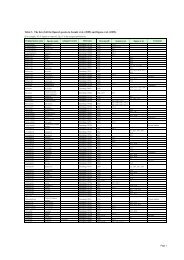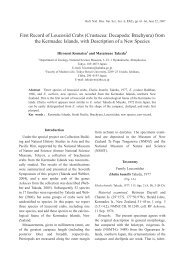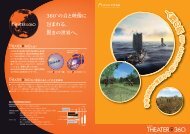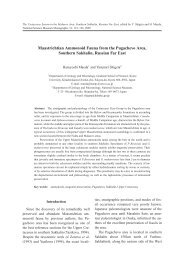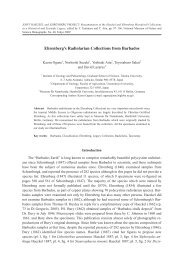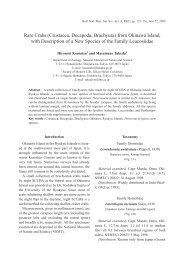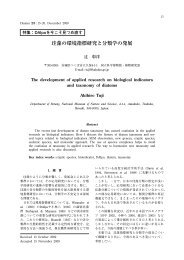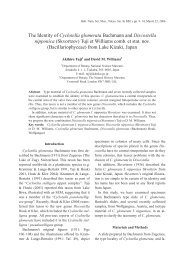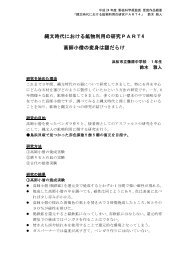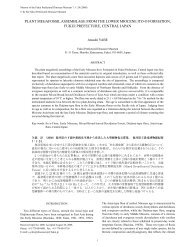Natl. Mus. Nat. Sci. Japan Monographs 40: 13-21 (2009)
Natl. Mus. Nat. Sci. Japan Monographs 40: 13-21 (2009)
Natl. Mus. Nat. Sci. Japan Monographs 40: 13-21 (2009)
Create successful ePaper yourself
Turn your PDF publications into a flip-book with our unique Google optimized e-Paper software.
JOINT HAECKEL and EHRENBERG PROJECT: Reexamination of the Haeckel and Ehrenberg Microfossil Collections<br />
as a Historical and <strong>Sci</strong>entific Legacy, edited by Y. Tanimura and Y. Aita, pp. <strong>13</strong>–<strong>21</strong>. <strong>Nat</strong>ional <strong>Mus</strong>eum of <strong>Nat</strong>ure and<br />
<strong>Sci</strong>ence <strong>Monographs</strong>, No. <strong>40</strong>, Tokyo <strong>2009</strong><br />
Examination of Type Material and Typification of Seven Diatoms Described<br />
by C. G. Ehrenberg<br />
Akihiro Tuji<br />
Department of Botany, <strong>Nat</strong>ional <strong>Mus</strong>eum of <strong>Nat</strong>ure and <strong>Sci</strong>ence, 4–1–1, Amakubo, Tsukuba 305–0005, <strong>Japan</strong><br />
(e-mail: tuji@kahaku.go.jp)<br />
Abstract Seven diatoms (Cocconeis lineata, Cocconeis placentula, Gallionella sculpta, Gomphonema<br />
subtile, Gomphonema vibrio, Navicula rhomboides, Stephanodiscus sinensis) described by<br />
Christian Gottfried Ehrenberg were examined using the materials in the Ehrenberg Collection in<br />
BHUPM (<strong>Mus</strong>eum für <strong>Nat</strong>urkunde in Berlin). Lectotypes and epitypes are designated for these taxa.<br />
Key words: Ehrenberg, diatoms, Cocconeis lineata, Cocconeis placentula, epitype, Gallionella<br />
sclpta, Gomphonema subtile, Gomphonema vibrio, lectotype, Navicula rhomboids, Stephanodiscus<br />
sinensis.<br />
Introduction<br />
Christian G. Ehrenberg was an early and important diatomist. Recent diatomists use many of<br />
the diatom names described by him. To understand <strong>Japan</strong>ese diatom endemism, I examined historical<br />
diatom collections in European herbariums. In this paper, I discuss the seven diatom taxa<br />
described by Ehrenberg.<br />
Materials and Methods<br />
I examined material from Ehrenberg’s Collection (EC) in the BHUPM (<strong>Mus</strong>eum für<br />
<strong>Nat</strong>urkunde in Berlin; Lazarus and Jahn, 1998), which consisted of the following:<br />
1. Ehrenberg’s original raw material (EC sample),<br />
2. Ehrenberg’s original mica preparations (EC mica), and<br />
3. Ehrenberg’s original drawings (EC drawing).<br />
I also referred to the geographic index by Clara Ehrenberg (ECGI) housed in the BHUPM,<br />
when searching the Ehrenberg collection. Several subsamples from Ehrenberg’s original material<br />
were incinerated or oxidized with H 2 O 2 and mounted onto glass slides and embedded in Pleurax<br />
or Zrax.
14 A. Tuji<br />
Results and Discussion<br />
1. Stephanodiscus sinensis Ehrenb. Mikrogeol. 144. pl. 34/7. f. 7. 1854. (Fig. 1, a–e)<br />
Type locality: Blumencultur-Erde von Canton, China.<br />
Lectotype (here designated): An illustration in EC drawing number 1996 (Fig. 1, a).<br />
Epitype (here designated): An individual in EC Mica 070203-4g (Fig. 1. e).<br />
Iso-epitype: EC sample 446a and 446b (292. Gelbliche Blumen-Erde von Canton A) (Fig. 1, d)<br />
The drawing of Stephanodiscus sinensis Ehrenb. is found in EC drawing 1996 (Fig. 1, a). I<br />
designate this drawing as the lectotype for this taxon. The mica number for this taxon is written<br />
in this drawing, and also agrees with the description in ECGI. This taxonomic name is written on<br />
the label of EC mica 070203-4g (Fig. 1, c), and a suitable individual is found on this mica. I designate<br />
this individual as the epitype for the support of the lectotype.<br />
Two EC samples for this taxon were found in the Ehrenberg Collection in the BHUPM (446a<br />
and 446b). These materials include so many taxa that I have not found suitable individuals for<br />
this taxon. Further study is needed to taxonomically identify this taxon.<br />
Figs 1. a–e. Stephanodiscus sinensis Ehrenb. a. EC drawing 1996, b. Ehrenberg (1854). Mikrogeol. pl. 34/7. f. 7.,<br />
c. the label of in EC Mica 070203-4g. d. the label of EC sample 446a. e. An individual in EC Mica 070203-<br />
4g, epitype, bar�10 mm.
Seven Diatoms by C. G. Ehrenberg 15<br />
2. Gallionella sculpta Ehrenb. Ber. K. Akad. Wiss. Berlin 1845: 61, 77. 1845; Mikrogeol. pl.<br />
33/12. f. 20. 1854. (Fig. 2, a–c)<br />
Type locality: Oregon, fossil.<br />
Lectotype (here designated): An illustration in EC drawing 2288 (Fig. 2, a).<br />
Epitype (here designated): An individual in EC mica 2<strong>40</strong>909-1o (Fig. 2, c).<br />
Iso-epitype: EC sample 1418.<br />
The drawing of Gallionella sculpta Ehrenb. is found in EC drawing 2288 (Fig. 2, a). I designate<br />
this drawing as the lectotype for this taxon. The mica number is described in ECGI; this taxonomic<br />
name is written on the label of EC mica 2<strong>40</strong>909-1o, and a suitable individual is found on<br />
this EC mica. I designate this individual as the epitype supporting the lectotype.<br />
3. Navicula rhomboides Ehrenb. Abh. Köningl. Akad. Wiss. Berlin 1841: 314, 419. f. 3-1-15.<br />
1843. (Fig. 2, d–f: EC Mica 200312-4r)<br />
The type material of this taxon was examined by Lange-Bertalot and Jahn (2000). I present<br />
Fig. 2. a–c, Gallionella sclpta Ehrenb. a. An illustration in EC drawing 2288 (lectotype). b, c. individuals found<br />
in EC Mica 2<strong>40</strong>909-1o, bar�10 mm. c. epitype.<br />
Fig. 2. d–f, Navicula rhomboides Ehrenb. Individuals found on EC Mica 200312-4r, bar�10 mm.
16 A. Tuji<br />
additional images for this taxon. This taxon is very close to Navicula rhynchocephala Kütz., and<br />
the two may be synonymous.<br />
4. Gomphonema subtile Ehrenb. Ber. K. Akad. Wiss. Berlin 1841: 144. 1841; Mikrogeol. pl.<br />
17/2. f. 43. 1854. (Fig. 3, a–c)<br />
Type locality: New York. Bridgewater, Mass.<br />
Lectotype (here designated): An illustration in EC drawing 2253 (Fig. 3, a).<br />
Epitype (here designated): An individual in EC mica 260301-1v (Fig. 3, b).<br />
The drawing of Gomphonema subtile Ehrenb. is found in EC drawing 2253 (Fig. 3, a). I designate<br />
this drawing as the lectotype for this taxon. The mica number is described in ECGI, and<br />
this taxonomic name is written on the label of EC mica 260301-1v. The individual on this mica<br />
agrees completely with the drawing, and I designate this individual as the epitype supporting the<br />
lectotype.<br />
5. Gomphonema vibrio Ehrenb. Abh. Köningl. Akad. Wiss. Berlin 1841: 416. f. 2-1-<strong>40</strong>. 1843.<br />
Type: Mahé, Seychelles, Van Heurck, Types Synopsis No. 2<strong>13</strong> (BORD) (typ. cons.). (Fig. 3, c, d)<br />
I found a suitable EC drawing (Fig. 3, c) and individual on EC mica (Fig. 3, d). However, the<br />
type of this taxon has been conserved in the International Code of Botanical Nomenclature<br />
(ICBN: McNeill et al., 2007) because it falls outside the range of variation in this taxon as currently<br />
understood (Jahn and Lange-Bertalot, 1995). Because of the conservation of type, these<br />
materials are not type material.<br />
6. Cocconeis placentula Ehrenb. Infus. vollk. org. 194. 1838; Mikrogeol. pl. 9-I. f. 46. 1854.<br />
(Fig. 3, e, f)<br />
Type locality: Bei Berlin.<br />
Lectotype (here designated): An illustration in Mikrogeologie (Ehrenberg 1854) (Pl. 9-I, Fig.<br />
46a) (Fig. 3, g).<br />
Cocconeis placentula Ehrenb. was described by Ehrenberg (1838) without figures from near<br />
Berlin. Figures of this taxon were published in Ehrenberg (1843) (Fig. 3, g, h), but not from<br />
Berlin. The figure in Ehrenberg (1854) comes from “Kieselguhr von Ceyssat, Puy de Dome” and<br />
seems to be the same locality as Ehrenberg (1838). I designate this figure as the lectotype for this<br />
taxon.<br />
7. Cocconeis lineata Ehrenb. Abh. Köningl. Akad. Wiss. Berlin 1841: 318, 369. 1843; Mikrogeol.<br />
pl. 6. f. <strong>40</strong>. pl. 9-I. f. 47. 1854.<br />
Type locality: Atotonilco el Grande, Mexico.<br />
Lectotype (here designated): An illustration in Mikrogeologie (Ehrenberg 1854) (Pl. 9-I, Fig. 47)<br />
(Fig. 3, f).<br />
Cocconeis lineata Ehrenb. was described in Ehrenberg (1843) from Atotonilco el Grande,<br />
Mexico, without a figure. The figures for this taxon were published in Ehrenberg (1854) from<br />
“Bergmehl von Santafiora” (Ehrenberg 1854: Pl. 6, Fig. <strong>40</strong>) and “Kieselguhr von Ceyssat, Puy de<br />
Dome” (Ehrenberg 1854: Pl. 9-I, Fig. 47). Both localities do not agree with the first description
Seven Diatoms by C. G. Ehrenberg 17<br />
Fig. 3. a, b. Gomphonema subtile Ehrenb. a. An illustration in EC drawing 2253 (lectotype). b. An individual in<br />
EC Mica 260301-1v (epitype).<br />
Fig. 3. c, d. Gomphonema Vibrio Ehrenb. c. A drawing in EC drawing 2053. d. an individual on EC mica<br />
180516-5bl<br />
Fig. 3. e, f. Cocconeis lineata Ehrenb. e. Ehrenberg (1854). Mikrogeol. pl. 6. f. <strong>40</strong>. f. Ehrenberg (1854). Mikrogeol.<br />
pl. 6. f. <strong>40</strong>. pl. 9-I. f. 47.<br />
Fig. 3. g–i. Cocconeis placentula Ehrenb. g, h. Ehrenberg (1843). i. Ehrenberg (1854). Mikrogeol. pl. 6. f. <strong>40</strong>. pl.<br />
9-I. f. 46.
18 A. Tuji<br />
Fig. 4. Individuals found on EC mica (330805-4bl). Cocconeis lineata Ehrenb. and/or Cocconeis placentula<br />
Ehrenb., bar�10 mm.<br />
of this taxon. However, illustration is an important part of identification, and I designate a figure<br />
from “Kieselguhr von Ceyssat, Puy de Dome” (Ehrenberg 1854: Pl. 9-I, Fig. 47) as the lectotype<br />
for this taxon.<br />
The EC mica (330805-4bl: Fig. 4) and EC sample (2225: Figs. 5, 6), which were indicated as<br />
the original material of Mikrogeologie plate 9-I by ECGI, were found for two taxa, Cocconeis<br />
placentula and C. lineata in the Ehrenberg Collection. No information is on the label of the EC<br />
mica. The microscopic images on EC mica number 330805-4bl are shown in Figure 4. Though<br />
Ehrenberg (1854) suggested the coexistence of both taxa, I cannot divide two morphological<br />
types in Cocconeis individuals. Because of the low resolving power on the EC mica and no information<br />
on the label, the EC mica does not give enough information to differentiate both taxa.
Seven Diatoms by C. G. Ehrenberg 19<br />
Fig. 5. Individuals found from a slide made from EC sample 2225, bar�10 mm. Cocconeis lineata Ehrenb. and/<br />
or Cocconeis placentula Ehrenb.
20 A. Tuji<br />
Fig. 6. Individuals found in EC sample 2225, a. bar�10 mm, b. bar�5 mm, c. bar�2 mm, d. bar�5 mm, e.<br />
bar�5 mm, f. bar�10 mm. Cocconeis lineata Ehrenb. and/or Cocconeis placentula Ehrenb.<br />
Since EC sample 2225 is original raw material for the EC mica and figures in Ehrenberg (1854),<br />
it is most suitable for distinguishing both taxa. The light microscopy images in EC sample 2225<br />
are shown in Figure 5, and scanning electron microscopy images from the Sample are shown in<br />
Figure 6. Although the range in valve size is very large, the morphological variation in Figures 5<br />
and 6 seems to be the variation of one taxon. Ehrenberg may have distinguished the raphid valve<br />
and araphid valve as different taxa.
Seven Diatoms by C. G. Ehrenberg <strong>21</strong><br />
Acknowledgments<br />
I thank Dr. David Lazarus, <strong>Mus</strong>eum für <strong>Nat</strong>urkunde in Berlin, for the use of his laboratory<br />
facilities and his help in searching Ehrenberg’s Collection.<br />
References<br />
Ehrenberg, C. G., 1838. Die Infusionsthierchen als vollkommene Organismen. Ein Blick in das tiefere organische Leben<br />
de <strong>Nat</strong>ur. Verlag von Leopold Voss, Leipzig. pp. i–xvii, 1–548, pls. 1–64.<br />
Ehrenberg, C. G., 1843. Verbreitung und Einflufs des mikroskopischen Lebens in Süd-und Nord-Amerika. Abh. Königl.<br />
Preuß, Akad. Wiss. Berlin, 1841: 291–445, 4 pls.<br />
Ehrenberg, C. G., 1854. Mikrogeologie. Das Erden und felsen schaffende Wirken des unsichtbar kleinen selbstständigen<br />
Lebens auf der Erde. Texte. Leopold Voss, Leipzig, 374 p, <strong>40</strong> pls.<br />
Jahn, R. & H. Lange-Bertalot, 1995. Proposal to conserve the name Gomphonema vibrio Ehrenb. (Bacillariophyceae)<br />
with a conserved type. Taxon, 44: 2<strong>21</strong>–222.<br />
Lange-Bertalot, H. & R. Jahn, 2000. On the identity of Navicula (Frustulia) rhomboides and Frustulia saxonica (Bacillariophyceae).<br />
Sys. Geogr. Plants, 70: 255–261.<br />
Lazarus, D. & R. Jahn, 1998. Using the Ehrenberg collection. Diatom Res., <strong>13</strong>: 273–291.<br />
Mcneill, J., F. R. Barrie, H. M. Burdet, V. Demoulin, D. Hawksworth, K. Marhold, D. H. Nicolson, J. Prado, P. C. Silva, J.<br />
E. Skog, J. H. Wiersema & N. J. Turland (eds.), 2007. International Code of Botanical Nomenclature (Vienna<br />
Code) adopted by the Seventeenth International Botanical Congress Vienna, Austria, July 2005. Gantner, Ruggell.<br />
Regnum Vegetabile: 146, XVIII: 568 pp.



